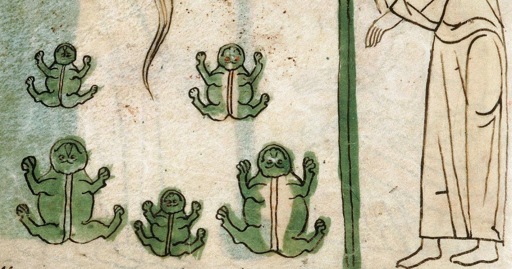- 171 Posts
- 58 Comments
And it works just as well, if we reverse the roles:
🪨🪨🪨🪨🪨
🪨🪨🪨🪨🪨
🪨Human: There are 11 rocks.
Alien: Oh, you must be using base A. See, I use base 10.
Human: No, I use base 10. What is base A?
Game report: Yesterday I played my illusion wizard, creatively named Lusion in a one shot. The adventure was simple: Goblins nap a kid, party comes to rescue. Guardian, ranger, sorcerer, and wizard.
Figment is a funny thing to mess around. For example, Lusian conjured a big red sign to mock the ranger’s scouting.
In the initial encounters, the illusionist mostly watched the ranger killing goblins.
He did scare off the goblins in their entrance rooms with a “GRENADE!!” but that was just a non-magical ruse. High deception, performance, etc skills helps with such stuff though.
The boss fight was against two minions, an alchemist, and a healer goblin. The alchemist showed high initiative and doused the party in fire but then Lusion gave him a stern look and told him to drop prone (Command, the Goblin crit-failed his save). The ranger did the final dirty work and the kid was rescued.
Sadly, I didn’t get to use Illusory Object or Charming Push.
This is the full spellbook currently:
Arcane Prepared Spells DC 17, attack +7; 1st illusory object, command, dizzying colors; Cantrips (1st) daze, detect magic, figment, shield, telekinetic projectile, prestidigitation
Wizard Focus Spells DC 17, attack +7, 1 focus point; 1st charming push

 1·1 month ago
1·1 month agoI have read stories that D&D in the 70s it was normal to have groups of 10-20 people. There were player roles like “mappers” for drawing the map. There was a “caller” who summarized the player moves for the GM.
You are not alone.
I use “m”. Here is how to set the default btw:
git config set --global init.defaultBranch m

 10·2 months ago
10·2 months agoThe book alone is already funny. Their faces though…

 4·2 months ago
4·2 months agoRunehammer has a nice video on Timers with some more examples.

 47·5 months ago
47·5 months agoHow do you know? Did you actually read the article or what?? 😉

 1·6 months ago
1·6 months agoSo you’re looking for discussions like: Is Gandalf a wizard, sorcerer, or cleric? Which level are his spells?
Sounds like fun. 😄

 21·6 months ago
21·6 months agoYou cannot really separate setting and system. For example, the D&D system uses Vancian magic. That isn’t how magic works in Lord of the Rings. So you cannot „see Lotr through the lens of the D&D system“.

 4·6 months ago
4·6 months agoYoutube interview of Mercer about the Hope-Fear mechanic.
I had no chance to try it myself.

 3·6 months ago
3·6 months agoCompared to Dungeon World, the Hope/Fear counters are a difference.
I’m not sure where they got it from. To me it seems somewhat like Fate points.

 5·6 months ago
5·6 months agoWhat is PbtA? Well, the Baker’s definition:
“Powered by the Apocalypse” isn’t the name of a kind of game, set of game elements, or even the core design thrust of a coherent movement. (Ha! This last, the least so.) Its use in a game’s trade dress signifies ONLY that the game was inspired by Apocalypse World in a way that the designer considers significant, and that it follows our policy wrt others’ use of our creative work.
Is Daggerheart inspired by Apocalypse World? I think so: Meguey Baker co-authored Apocalypse World and the post-apocalyptic “Motherboard” campaign frame in Daggerheart. I would be surprised if Mercer would not have credited PbtA somewhere. If Darrington Press would like to, Meg and Vincent would probably approve with the “PbtA” stamp.
It doesn’t use the “2d6+stat” role mechanic but that is not essential just like all the other game mechanics.
I’m sorry. This is probably not very helpful. Maybe a more precise answer could be given if you ask how it diverges from “Dungeon World” or some other PbtA game you know.

 3·6 months ago
3·6 months agoIt seems to me like all the Youtubers actually agree: This Daggerheart license is not as bad as OGL but there are some parts which raise concerns.
It isn’t a problem for now but imagine a future where someone big (like Hasbro or Disney or…) buys the rights to Daggerheart and wants to extract more money from the IP. Having experienced WotC, the TTRPG community is sensitive about it, so it seems appropriate to demand some more explanation from Darrington Press.
Symbolic City’s Big, Last Minute Free RPG Day Sale.
Free RPG Day 2025 by StarshineScribbles.
Free Indie RPG Collection BUNDLE on DrivethruRPG

 2·7 months ago
2·7 months agoOn a scale of 0 (no clue what they are doing) to 10 (there is a master plan with a hundred steps), how strategic is Critical Role?
My guess would be around 3. This is mostly „seems like a cool idea, let’s do it“ without much of a plan.


















You can watch the first minutes of this interview with Travis and Matt.
The short answer seems to be: The decision to use D&D was made months earlier and they were too committed to that already.